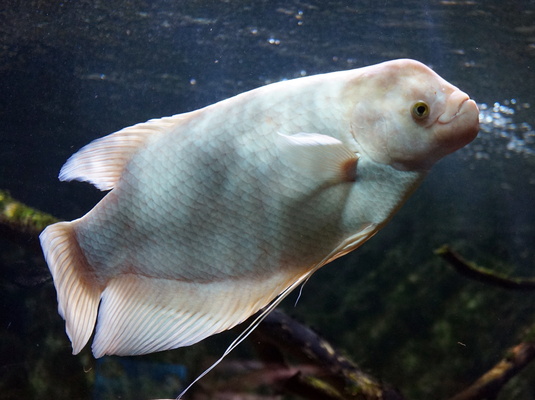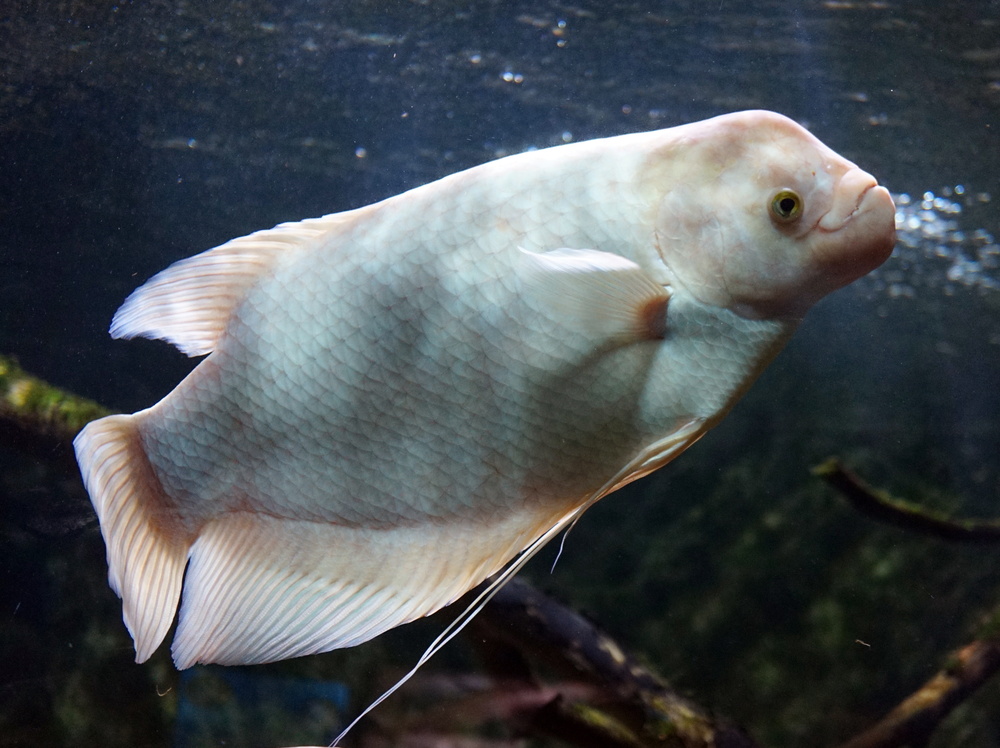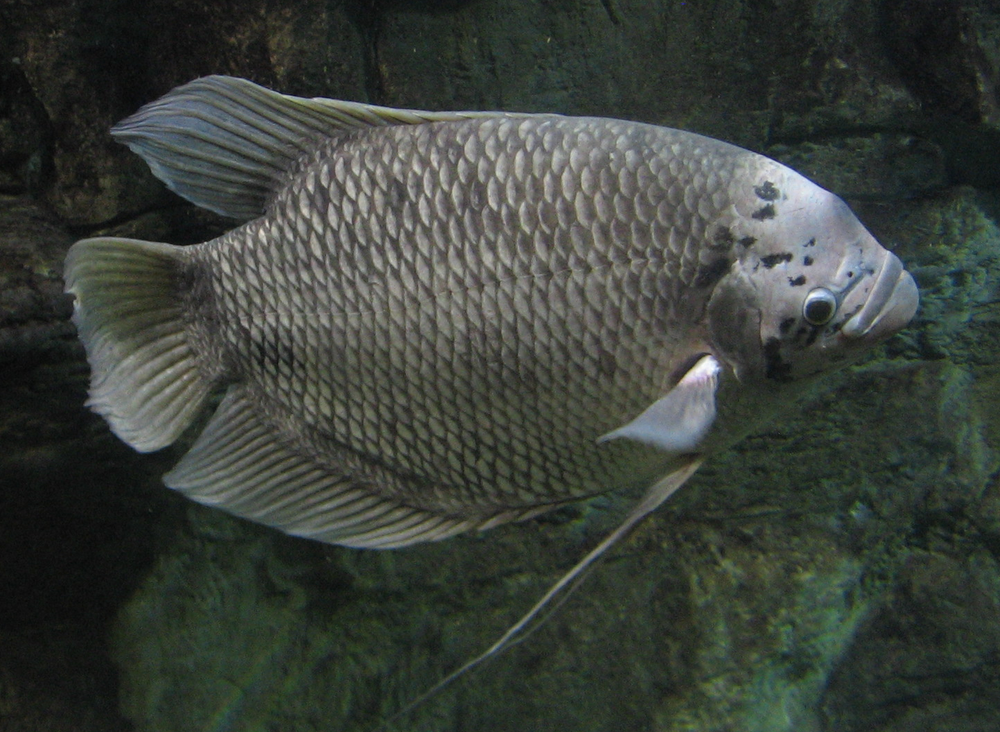Information
Version: B | 1.1 (2022-01-22)
WelfareScore | farm
Condensed assessment of the species' likelihood and potential for good fish welfare in aquaculture, based on ethological findings for 10 crucial criteria.
- Li = Likelihood that the individuals of the species experience good welfare under minimal farming conditions
- Po = Potential of the individuals of the species to experience good welfare under high-standard farming conditions
- Ce = Certainty of our findings in Likelihood and Potential
WelfareScore = Sum of criteria scoring "High" (max. 10)
General remarks
Osphronemus goramy of the family Osphronemidae is originally living in freshwater bodies of Southeast Asia. By now, it has been introduced into Europe, Australia, and India. Despite its slow growth and low fecundity, it is being assumed suitable for farming due to its air breathing, which makes it withstand low oxygen levels in ponds, and the possibility to thrive on a mostly plant-based diet. Farming has probably been done for hundreds of years and has increased in intensity, while the wild stocks have decreased. A main caveat in production is the large variation in reproduction partially assumed to be caused by unfavourable sex ratios, but non-invasive sexing might be one way of improvement.
For O. goramy to increase its FishEthoScore, more research is needed on the biology and on natural conditions of home range, depth, migration, reproduction, aggregation, aggression, substrate, as well as on water parameter requirements, stress, and stunning. High mortality in larvae and fry stage and decrease in reproduction in spawners might be reduced by moving hatcheries and broodstock facilities inside to protect them from sun and rain, predators, disease, and noise and to better control water parameters.
Note: Due to reaching maturity after the typical age and weight at slaughter, there is no age class "Adults" in the profile.
1 Home range
Many species traverse in a limited horizontal space (even if just for a certain period of time per year); the home range may be described as a species' understanding of its environment (i.e., its cognitive map) for the most important resources it needs access to.
What is the probability of providing the species' whole home range in captivity?
It is unclear for minimal and high-standard farming conditions. Our conclusion is based on a low amount of evidence.


2 Depth range
Given the availability of resources (food, shelter) or the need to avoid predators, species spend their time within a certain depth range.
What is the probability of providing the species' whole depth range in captivity?
It is low for minimal farming conditions. It is medium for high-standard farming conditions. Our conclusion is based on a medium amount of evidence.


3 Migration
Some species undergo seasonal changes of environments for different purposes (feeding, spawning, etc.), and to move there, they migrate for more or less extensive distances.
What is the probability of providing farming conditions that are compatible with the migrating or habitat-changing behaviour of the species?
It is unclear for minimal and high-standard farming conditions. Our conclusion is based on a low amount of evidence.


4 Reproduction
A species reproduces at a certain age, season, and sex ratio and possibly involving courtship rituals.
What is the probability of the species reproducing naturally in captivity without manipulation of theses circumstances?
It is unclear for minimal farming conditions. It is medium for high-standard farming conditions. Our conclusion is based on a low amount of evidence.


5 Aggregation
Species differ in the way they co-exist with conspecifics or other species from being solitary to aggregating unstructured, casually roaming in shoals or closely coordinating in schools of varying densities.
What is the probability of providing farming conditions that are compatible with the aggregation behaviour of the species?
It is unclear for minimal and high-standard farming conditions. Our conclusion is based on a low amount of evidence.


6 Aggression
There is a range of adverse reactions in species, spanning from being relatively indifferent towards others to defending valuable resources (e.g., food, territory, mates) to actively attacking opponents.
What is the probability of the species being non-aggressive and non-territorial in captivity?
It is low for minimal farming conditions. It is medium for high-standard farming conditions. Our conclusion is based on a low amount of evidence.


7 Substrate
Depending on where in the water column the species lives, it differs in interacting with or relying on various substrates for feeding or covering purposes (e.g., plants, rocks and stones, sand and mud, turbidity).
What is the probability of providing the species' substrate and shelter needs in captivity?
It is low for minimal farming conditions. It is medium for high-standard farming conditions. Our conclusion is based on a medium amount of evidence.


8 Stress
Farming involves subjecting the species to diverse procedures (e.g., handling, air exposure, short-term confinement, short-term crowding, transport), sudden parameter changes or repeated disturbances (e.g., husbandry, size-grading).
What is the probability of the species not being stressed?
It is low for minimal farming conditions. It is medium for high-standard farming conditions. Our conclusion is based on a low amount of evidence.


9 Malformations
Deformities that – in contrast to diseases – are commonly irreversible may indicate sub-optimal rearing conditions (e.g., mechanical stress during hatching and rearing, environmental factors unless mentioned in crit. 3, aquatic pollutants, nutritional deficiencies) or a general incompatibility of the species with being farmed.
What is the probability of the species being malformed rarely?
There are no findings for minimal and high-standard farming conditions.


10 Slaughter
The cornerstone for a humane treatment is that slaughter a) immediately follows stunning (i.e., while the individual is unconscious), b) happens according to a clear and reproducible set of instructions verified under farming conditions, and c) avoids pain, suffering, and distress.
What is the probability of the species being slaughtered according to a humane slaughter protocol?
It is low for minimal and high-standard farming conditions. Our conclusion is based on a low amount of evidence.


Side note: Domestication
Teletchea and Fontaine introduced 5 domestication levels illustrating how far species are from having their life cycle closed in captivity without wild input, how long they have been reared in captivity, and whether breeding programmes are in place.
What is the species’ domestication level?
DOMESTICATION LEVEL 4 19, level 5 being fully domesticated. Life cycle closed around 1900 1, pond culture much older 20-17, probably for centuries 4.
Side note: Forage fish in the feed
450-1,000 milliard wild-caught fishes end up being processed into fish meal and fish oil each year which contributes to overfishing and represents enormous suffering. There is a broad range of feeding types within species reared in captivity.
To what degree may fish meal and fish oil based on forage fish be replaced by non-forage fishery components (e.g., poultry blood meal) or sustainable sources (e.g., soybean cake)?
WILD: herbivorous 21, omnivorous with vegetarian focus 18. FARM: for JUVENILES, fish meal and fish oil may be partly* replaced by plants 22 18, SPAWNERS were mainly fed with plants 2, but no data found yet on replacements for FRY.
*partly = <51% – mostly = 51-99% – completely = 100%
Glossary
EURYHALINE = tolerant of a wide range of salinities
FARM = setting in farming environment or under conditions simulating farming environment in terms of size of facility or number of individuals
FRY = larvae from external feeding on, for details ➝ Findings 10.1 Ontogenetic development
IND = individuals
JUVENILES = fully developed but immature individuals, for details ➝ Findings 10.1 Ontogenetic development
LAB = setting in laboratory environment
LARVAE = hatching to mouth opening, for details ➝ Findings 10.1 Ontogenetic development
PHOTOPERIOD = duration of daylight
SPAWNERS = adults during the spawning season; in farms: adults that are kept as broodstock
WILD = setting in the wild
Bibliography
2 Kristanto, Anang Hari, Jacques Slembrouck, Jojo Subagja, Simon Pouil, Otong Zenal Arifin, Vitas Atmadi Prakoso, and Marc Legendre. 2019. Survey on egg and fry production of giant gourami (Osphronemus goramy): Current rearing practices and recommendations for future research. Journal of the World Aquaculture Society n/a: 20. https://doi.org/10.1111/jwas.12647.
3 Woynarovich, E., and L. Horváth. 1980. The artificial propagation of warm-water finfishes - a manual for extension. FAO Fisheries Technical Paper 201. Rome: Food and Agriculture Organization of the United Nations.
4 Caruso, D., Z. O. Arifin, J. Subagja, Jacques Slembrouck, and M. New. 2019. Cultured Aquatic Species Information Programme. Osphronemus goramy (Lacépède, 1801). Rome: FAO Fisheries and Aquaculture Department.
5 Slembrouck, Jacques, Otong Z. Arifin, Simon Pouil, Jojo Subagja, Akhmad Yani, Anang H. Kristanto, and Marc Legendre. 2019. Gender identification in farmed giant gourami (Osphronemus goramy): A methodology for better broodstock management. Aquaculture 498: 388–395. https://doi.org/10.1016/j.aquaculture.2018.08.056.
6 Kah-Wai, Kong, and Ahyaudin B. Ali. 2001. Chenderoh Reservoir, Malaysia: Fish Community and Artisanal Fishery of a Small Mesotrophic Tropical Reservoir. In ACIAR Proceedings, 98:167–178. Bangkok, Thailand.
7 Djumanto, nFN, Maria Intan P. Devi, and Eko Setyobudi. 2013. Ichthyofauna distribution in downstream region of Opak River, Yogyakarta [Persebaran iktiofauna di bagian hilir Sungai Opak, Yogyakarta]. Jurnal Iktiologi Indonesia 13: 97–108. https://doi.org/10.32491/jii.v13i2.97.
8 Bhimachar, B. S., Augustine David, and B. Muniappa. 1944. Observations on the acclimatisation, nesting habits and early development of Osphronemus gorami (Lacépède). Proceedings of the Indian Academy of Sciences-Section B 20: 88–101.
9 Amornsakun, Thumronk, Surasak Kullai, and Anuar Hassan. 2014. Some aspects in early life stage of giant gourami, Osphronemus goramy (Lacepede) larvae. Songklanakarin Journal of Science and Technology 36: 493–498.
10 Jalal, K. C. A., M. Ahmad Azfar, B. Akbar John, Y. B. Kamaruzzaman, and S. Shahbudin. 2012. Diversity and Community Composition of Fishes in Tropical Estuary Pahang Malaysia. Pakistan J. Zool. 44: 181–187.
11 Prasad, A. G. Devi, G. V. Venkataramana, and Mathew Thomas. 2009. Fish diversity and its conservation in major wetlands of Mysore. Journal of Environmental Biology 30: 713–718.
12 Hashim, Zarul Hazrin, Amir Shah Ruddin Md. Shah, Mohd. Syaiful Mohammad, Mashhor Mansor, and Shahrul Anuar Mohd. Sah. 2012. Fishes of Sungai Enam and Sungai Telang in Temengor Reservoir, Perak, Malaysia. Check List 8: 027–031. https://doi.org/10.15560/8.1.027.
13 Shafiq, Zakeyuddin Mohd, Md Shah Amir Shah Ruddin, Hazrin Hashim Zarul, Mohammad Mohd Syaiful, Md Zain Khaironizam, Puteh Khaled, and Yusoff Hamzah. 2014. An annotated checklist of fish fauna of Bukit Merah Reservoir and its catchment area, Perak, Malaysia. Check List 10: 822–828. https://doi.org/10.15560/10.4.822.
14 Radhi, Amonodin Mohamad, Hashim Rohasliney, and Hazrin Zarul. 2017. Fish Composition and Diversity in Perak, Galas and Kelantan Rivers (Malaysia) After the Major Flood of 2014. Transyl. Rev. Sys. Ecol. Res. 19: 41–56.
15 Ismail, Siti Norasikin, Muzzalifah Abd Hamid, and Mashhor Mansor. 2018. Ecological correlation between aquatic vegetation and freshwater fish populations in Perak River, Malaysia. Biodiversitas Journal of Biological Diversity 19: 279–284. https://doi.org/10.13057/biodiv/d190138.
16 Cuadrado, Jerry Tioaquen, Danah Sofia Lim, Rydyll Mae S. Alcontin, Jan Lloyd L. Calang, and Joycelyn C. Jumawan. 2019. Species composition and length-weight relationship of twelve fish species in the two lakes of Esperanza, Agusan del Sur, Philippines. FishTaxa 4: 1–8.
17 Arifin, Otong Zenal, Vitas Atmadi Prakoso, Jojo Subagja, Anang Hari Kristanto, Simon Pouil, and Jacques Slembrouck. 2019. Effects of stocking density on survival, food intake and growth of giant gourami (Osphronemus goramy) larvae reared in a recirculating aquaculture system. Aquaculture 509: 159–166. https://doi.org/10.1016/j.aquaculture.2019.05.010.
18 Slembrouck, Jacques, Reza Samsudin, Brata Pantjara, Ahmad Sihabuddin, Marc Legendre, and Domenico Caruso. 2018. Choosing floating macrophytes for ecological intensification of small-scale fish farming in tropical areas: a methodological approach. Aquatic Living Resources 31: 9. https://doi.org/10.1051/alr/2018017.
19 Teletchea, Fabrice, and Pascal Fontaine. 2012. Levels of domestication in fish: implications for the sustainable future of aquaculture. Fish and Fisheries 15: 181–195. https://doi.org/10.1111/faf.12006.
20 Cuvier, Georges, and A. Valenciennes. 1828. Histoire naturelle des poissons. Paris, France: Levrault.
21 Azfar, A. M., K. C. A. Jalal, and A. Siti-Waznah. 2015. Food Partitioning Among Fishes in Phang River-Estuary, Malaysia. Jurnal Teknologi 77. https://doi.org/10.11113/jt.v77.6741.
22 Anh, Nguyen Thi Ngoc, Tran Thi Thanh Hien, and Tran Ngoc Hai. 2013. Potential Uses of Gut Weed Enteromorpha spp. as a Feed For Herbivorous Fish. In Special Publication, 4. Oostende, Belgium: European Aquaculture Society.








